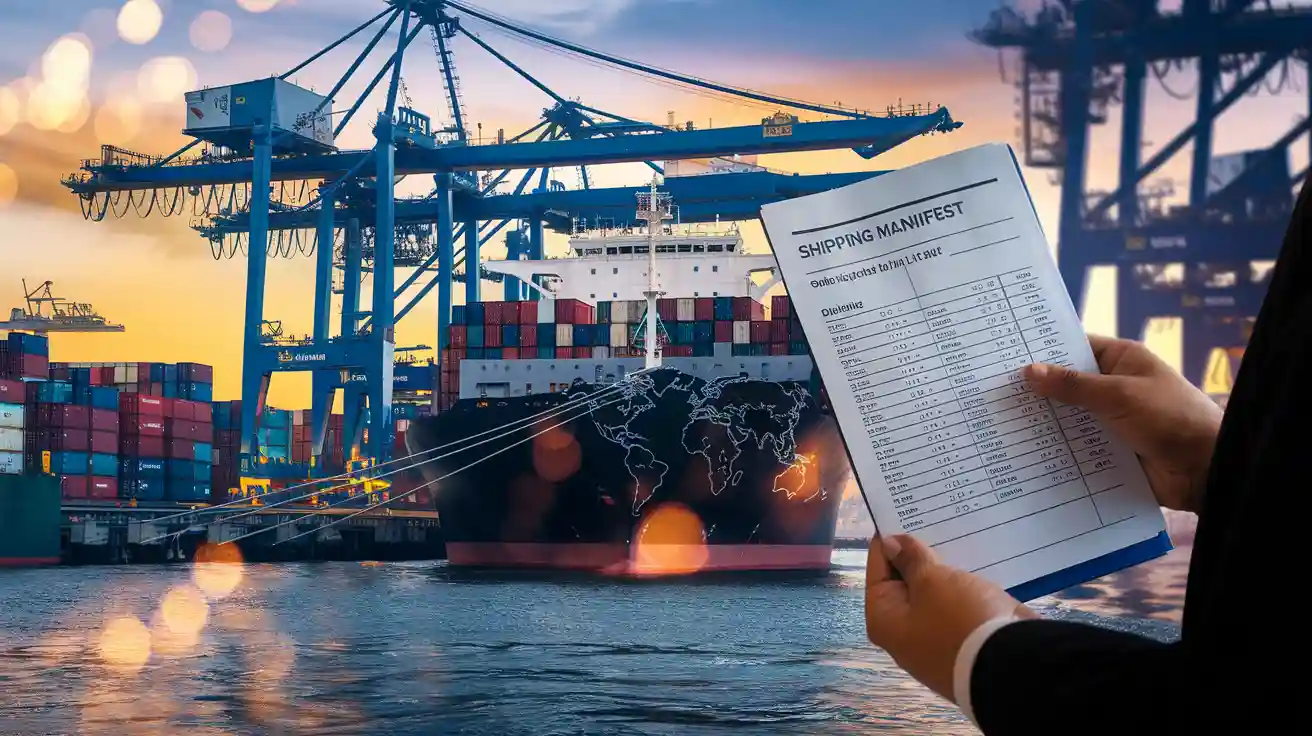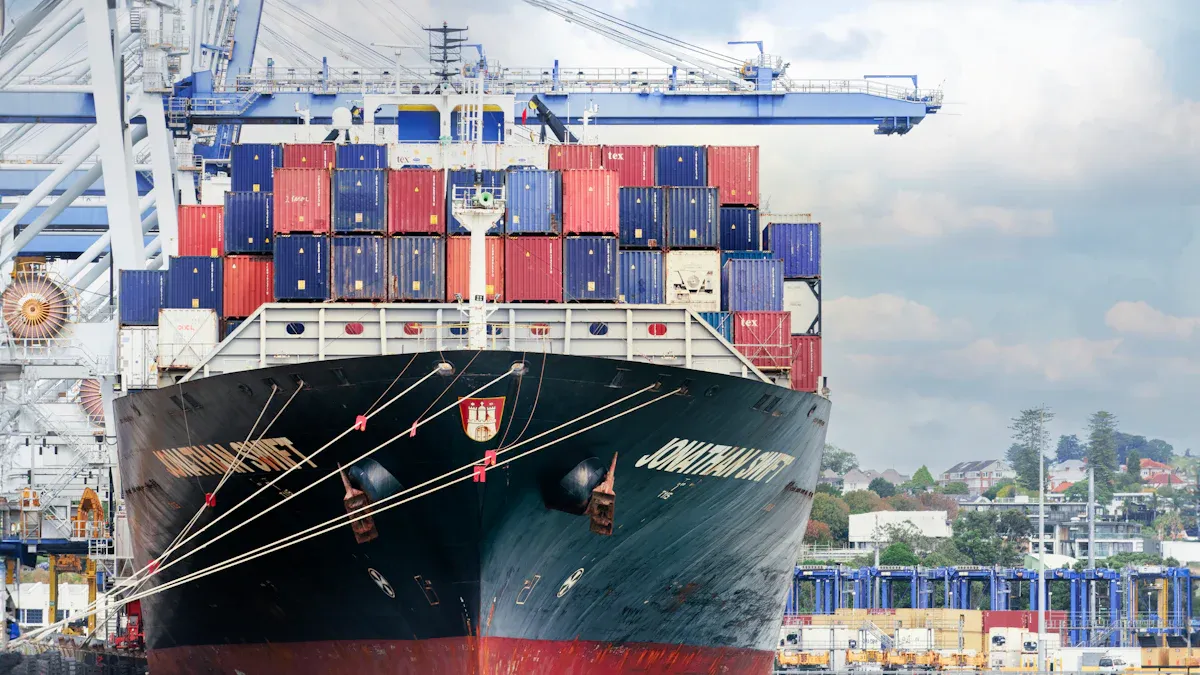Why Shipping Manifests Are Vital for Global Trade

Every day, over 90% of international trade moves by sea, and shipping manifests play a key role in this process. Shipping manifests provide clear records for every shipment, helping customs officials and businesses track cargo. These documents support international trade by reducing errors and delays. They also help in enhancing supply chain efficiency. Without shipping manifests, international trade would face confusion and higher costs. Their accuracy and detail ensure safe, legal movement of goods in global trade.
Shipping Manifests Overview

Definition and Purpose
A shipping manifest is a detailed document that lists all cargo loaded onto a vessel. In international shipping, the manifest serves as a key tool for logistics management, customs clearance, and cargo tracking. The cargo manifest provides customs officials and shipping companies with a clear record of every item on board. It acts as a legal record for port operations but does not serve as a contract like a Bill of Lading.
The main function of a cargo manifest is to ensure that every piece of cargo is accounted for during transport. Shipping manifests help track cargo from the point of origin to the final destination. They also support customs clearance by listing all cargo details, which helps prevent illegal shipments and ensures tax compliance. Different types of manifests exist, such as Import General Manifests, Container Manifests, Dangerous Cargo Manifests, Out of Gauge Manifests, and Reefer Manifests. Each type addresses specific cargo needs and regulatory requirements.
Note: The accuracy of a cargo manifest depends on the reliability of the Bill of Lading and the information provided by shippers.
Core Components
A standard cargo manifest includes several essential data fields. These fields help customs, carriers, and receivers understand exactly what cargo is being shipped. The main components are:
- Product descriptions for each cargo item
- Quantities and weights of all cargo
- Destination addresses and ports of arrival
- Harmonized system codes for customs classification
- Declared values for insurance and tax purposes
- Names of importers and exporters
- Country of origin for each cargo item
- Export and import declarations
- Packaging and handling instructions
- Emergency response procedures for hazardous materials
- Dimensions and special handling requirements for oversized cargo
- Temperature settings for perishable cargo
A cargo manifest also lists the specific Bills of Lading linked to the cargo on board. This information helps carriers and customs officials verify the shipment and resolve any disputes. By including all these details, shipping manifests support safe, legal, and efficient movement of cargo in global trade.
Importance in Global Trade
Regulatory Compliance
Shipping manifests play a vital role in enforcing trade laws and regulations in international trade. Authorities depend on the manifest to check the identity of shippers, the type of cargo, and the details of each shipment. This information helps customs officials track cargo and spot illegal shipments. For example, U.S. Customs and Border Protection uses advanced technology, such as artificial intelligence, to scan manifests and detect hidden threats. These tools have helped intercept shipments disguised as ordinary goods but containing illegal substances. The manifest also helps uncover cases of sanctions evasion, forced labor, and counterfeit goods in maritime freight. Legislation like the Manifest Modernization Act aims to close loopholes in air and vehicle manifests, making it harder for criminals to exploit the system. By providing transparency, the cargo manifest supports legal and safe movement of goods in global trade.
Shipping manifests give customs authorities the data they need to enforce import and export laws, prevent illegal trade, and protect national security.
Supply Chain Visibility
A cargo manifest improves supply chain visibility by offering detailed records of all cargo in transit. This document allows shippers, customs, and freight forwarding companies to coordinate their activities. The manifest provides real-time shipment information, which helps with inventory management and supply chain optimization. When all parties have access to accurate cargo data, they can plan better and avoid delays. Digital manifests make this process even smoother by allowing real-time updates and integration with other maritime logistics systems.
- Customs authorities use manifests to verify shipment contents and speed up customs clearance.
- Manifests help with real-time tracking and cargo tracking, improving communication between shippers and freight forwarding agents.
- The manifest acts as a legal document in case of disputes about cargo condition or contents.
- Electronic manifests reduce errors, support supply chain management, and enable supply chain optimisation.
The cargo manifest standardizes information sharing, which reduces mistakes and helps all partners in maritime freight work together efficiently. This level of coordination is essential for international trade and shipping logistics.
Customs and Security
Customs clearance at major international ports depends on the accuracy of the manifest. The cargo manifest lists every item, including special handling instructions and shipment routes. Customs officials use this information to process shipments quickly and safely. Different types of manifests, such as Import General Manifests and Dangerous Cargo Manifests, address specific cargo needs in maritime freight. Accurate manifests help avoid customs holds, double billing, or misrouted shipments. If errors occur, manifest correctors can fix them before the cargo arrives.
- Manifests ensure legal compliance and help avoid penalties or delays.
- They provide detailed documentation, reducing discrepancies that could lead to fines or confiscation.
- The manifest supports logistics management by enabling tracking and proper handling during transit.
- Accurate manifests help resolve issues during transportation, reducing risks for all stakeholders.
- The manifest acts as an official record, helping with dispute resolution and investigations.
Shipping manifests are essential for risk mitigation and secure delivery in global trade. They help customs authorities verify shipments, ensure compliance, and keep the supply chain moving smoothly. In maritime logistics, the manifest is the backbone of safe, legal, and timely cargo movement.
Cargo Manifest Types
Standard Manifests
A standard cargo manifest lists all items loaded onto a ship, truck, or plane. This document includes product names, quantities, weights, and destination details. Shippers and carriers use the cargo manifest to track each cargo item from the point of origin to the final destination. Standardized manifests help everyone in the supply chain, including freight forwarding companies, work together smoothly. They make it easier to check shipments, plan routes, and handle cargo at ports.
Standardized cargo manifests improve operational efficiency. They provide a clear inventory for tracking and verification. This transparency helps prevent theft or loss and supports legal compliance. Digital manifests allow real-time updates and connect with logistics software, making the process faster and more accurate.
Without a standard cargo manifest, planning efficient routes and meeting customs requirements becomes difficult. This can slow down global trade and increase costs for businesses.
Hazardous Materials
Hazardous materials need special attention in shipping. The cargo manifest for these goods must follow strict rules. Shippers must include extra details that are not required for standard cargo. These details help keep people and the environment safe.
- The manifest must list the identification number for each hazardous material.
- The proper shipping name, as set by regulations, must appear on the cargo manifest.
- The hazard class or division number must be stated, and sometimes the words “Class” or “Division” are added for clarity.
- Subsidiary hazard classes or division numbers are included if needed.
- The manifest must show special handling instructions and storage conditions.
- Emergency response telephone numbers must be listed.
Freight forwarding companies rely on these detailed cargo manifests to ensure safe transport. If hazardous materials are not declared correctly, it can lead to serious safety risks and legal problems. Standard cargo does not need these extra declarations or compliance steps.
Digitalization

Electronic Manifests
The shipping industry has moved from paper documents to digital cargo manifests. This change makes shipping faster and more accurate. Electronic manifests allow shippers, carriers, and customs officials to update and share information quickly. The EPA’s e-Manifest system lets all parties correct data electronically. Each change is certified and shared with everyone involved. This process keeps a clear record and reduces mistakes. Digital systems also use checks to catch errors before anyone submits the manifest. FIATA reports that digital Air Import General Manifest management cuts error rates by about 80% and reduces processing times by nearly half. These improvements help shipments clear customs faster and avoid delays.
Digital cargo manifests remove the need for manual paperwork. Shippers no longer wait for documents to travel between offices. Real-time tracking becomes possible, so everyone knows where the cargo is at any moment. This visibility helps companies plan better and respond quickly to changes. Standardized digital formats also make it easier to share information across different systems.
Automation Benefits
Automation brings many advantages to shipping manifest processes. Companies save money because computers handle tasks that people once did by hand. Fewer mistakes mean fewer fines and less wasted time. Employees feel better about their work because they spend less time on boring, repetitive jobs. Automation also speeds up delivery and processing, which helps companies stay competitive.
- Automation reduces paperwork and manual errors.
- Advance electronic submission speeds up customs clearance.
- Real-time tracking improves transparency.
- Early cargo information allows for better security checks.
- Integration with other logistics systems supports smooth supply chain operations.
When companies connect electronic manifests with other supply chain systems, they get real-time data on inventory and shipments. This connection helps them forecast demand, manage stock, and use warehouse space wisely. Electronic Data Interchange (EDI) removes paper-based steps and speeds up communication with partners. These changes make logistics more efficient and help companies adapt quickly to new challenges.
Challenges and Best Practices
Common Pitfalls
Shipping manifests can contain errors that lead to serious problems. Mistakes often happen when workers enter cargo details by hand or forget to update information. These errors can cause customs officials to hold shipments, which leads to delays and extra costs. Industry reports show that companies sometimes lose millions of dollars each year because of late deliveries and fines linked to manifest mistakes. For example, large shippers have lost an average of $14.6 million due to On-Time-In-Full fees caused by errors in cargo documentation. U.S. Customs can fine companies up to $5,000 for each violation. The impact of inaccurate manifests goes beyond money. Delays can damage business relationships and slow down supply chain management.
Customs authorities may hold cargo with manifest errors, causing immediate ecommerce shipping delays and financial penalties.
Ensuring Accuracy
Companies can avoid many problems by following best practices for preparing shipping manifests. Industry experts recommend these steps:
- Use barcode scanning to reduce manual errors and improve data visibility for each cargo item.
- Implement quality checks at every stage, such as picking, packing, loading, and unloading.
- Automate data entry with RFID, sensors, or software to save time and prevent mistakes.
- Standardize processes with clear procedures and guidelines for effective documentation.
- Train staff regularly so they understand how to handle cargo and complete manifests correctly.
- Conduct regular audits and cycle counts to catch and fix any issues quickly.
- Leverage technology for real-time tracking and reporting to support supply chain optimization.
These steps help companies keep cargo records accurate and up to date. They also support better supply chain management and reduce the risk of costly errors.
Compliance Tips
Timely and accurate submission of shipping manifests is key to smooth cargo movement. Companies should:
- Include a complete and current list of all cargo in each shipment.
- Provide detailed contact information for shippers and receivers.
- Specify origin and destination details for better tracking.
- Note any special handling needs to protect cargo during transport.
- Use digital formats for easier updates and tracking.
- Double-check all details before submitting the manifest.
- Keep copies for records, tracking, and insurance claims.
These tips help prevent delivery errors and support compliance with customs rules. Effective documentation builds trust and keeps the supply chain running smoothly.
Shipping manifests remain essential for global trade. They support compliance, efficiency, and security at every step. Many companies now use digital systems to share and check manifest data instantly. Industry leaders see digital manifests as key to faster reviews and fewer errors.
- AI and cloud platforms will drive real-time decisions and better tracking.
- Smart integrations will connect manifests with warehouse and order systems.
- Sustainability and transparency will shape the future of shipping manifests.
A connected world will rely on these advances to keep trade safe and efficient.
FAQ
What is the main purpose of a shipping manifest?
A shipping manifest lists all cargo on a vessel. It helps customs officials, shippers, and carriers track goods. This document ensures legal compliance and supports safe, efficient trade.
Who prepares the shipping manifest?
The shipper or freight forwarder usually prepares the shipping manifest. They collect cargo details from suppliers and enter the information into the manifest before shipping.
How does a digital manifest improve shipping?
A digital manifest allows real-time updates and quick sharing of cargo data. It reduces errors, speeds up customs checks, and helps companies track shipments more easily.
What happens if a manifest has errors?
Errors in a manifest can cause customs delays, fines, or shipment holds. Companies may lose money and face supply chain disruptions. Accurate manifests help avoid these problems.
Are shipping manifests required for all types of cargo?
Most countries require a shipping manifest for all international cargo. Special rules apply to hazardous materials. Shippers must follow these rules to ensure safety and compliance.
See Also
Inside Shein's Warehouse Operations And Worldwide Shipping Insights
The Hidden Financial Damage Caused By Shipment Errors
How Blind Shipping Enhances Efficiency In E-commerce Today
Three Strategies Lean Logistics Uses To Improve Sustainability
New EDI Tracking Technologies Transforming Shipment Transparency